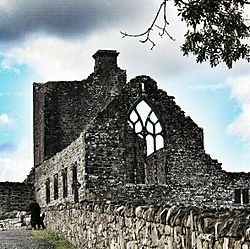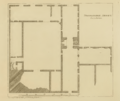Creevelea Abbey facts for kids
| Mainistir na Craoibhe Léithe | |
 |
|
| Monastery information | |
|---|---|
| Other names | Creevlea Abbey, Creebelea Abbey, Craobhliath, Crowlekale, Crueleach, Carrag Patrice, Petra Patricii, Druim-da-ethair, Baile-ui-ruairc, Ballegruaircy, Cuivelleagh, Killanummery. |
| Order | Third Order of Saint Francis (Order of Penance) |
| Established | 1508 |
| Disestablished | 1837 |
| Diocese | Kilmore |
| People | |
| Founder(s) | Eóghan Ó Ruairc |
| Architecture | |
| Status | Inactive |
| Site | |
| Location | Creevelea, Dromahair, County Leitrim |
| Coordinates | 54°13′53″N 8°18′35″W / 54.231291°N 8.309791°W |
| Visible remains | church walls, one or two unstable stairs, the perimeter structure. |
| Public access | yes, as a burial site |
| Reference #: | 69 |
Creevelea Abbey is an ancient friary in County Leitrim, Ireland. It was built long ago by a group of Franciscan monks. Today, it is a special National Monument and a quiet place used as a graveyard.
Contents
Where is Creevelea Abbey?
Creevelea Abbey is found in the west of Dromahair, a town in County Leitrim. It sits right on the west bank of the Bonet River.
A Look Back in Time: The History of Creevelea Abbey
Creevelea Friary was started in 1508 by a powerful leader named Eóghan O'Rourke. He was the Lord of West Bréifne. His wife, Margaret O'Brian, who was the daughter of a King of Thomond, also helped.
Sadly, the friary was accidentally burned in 1536. But don't worry, it was quickly rebuilt by Brian Ballach O'Rourke!
In 1590, a soldier named Richard Bingham used Creevelea as a place to keep his horses. He was chasing Brian O'Rourke, who had helped people who survived the Spanish Armada shipwrecks. Around 1598, the friary was officially closed down.
Some important people are buried here. One is Sir Tadhg O'Rourke, who was the last King of West Bréifne. Another is Thaddeus Francis O'Rourke, who was a Bishop.
The friars came back to Creevelea! A new building was made for them in 1618, and they moved back into the abbey in 1642. However, they were forced to leave again in the 1650s by the Cromwellian Army. After a time of peace, the abbey was used again until 1837.
What's Left of the Abbey Today?
Even though it's very old, you can still see many parts of Creevelea Abbey. The church walls are still standing, including the main areas like the nave, chancel, transept, and choir.
You can also see parts of the chapter house, where meetings were held, and the cloister. A cloister is a covered walkway, usually around a courtyard. The bell-tower was even changed into living spaces for the monks in the 1600s!
At one point, the church had a roof made of thatch, which is dried straw or reeds. If you look closely in the cloister, you might find a special carving. It shows Saint Francis of Assisi preaching to birds.
Protecting Creevelea Abbey
Creevelea Abbey is protected as a national monument. This means it's a very important historical site that is looked after so it can be preserved for the future.
Images for kids







